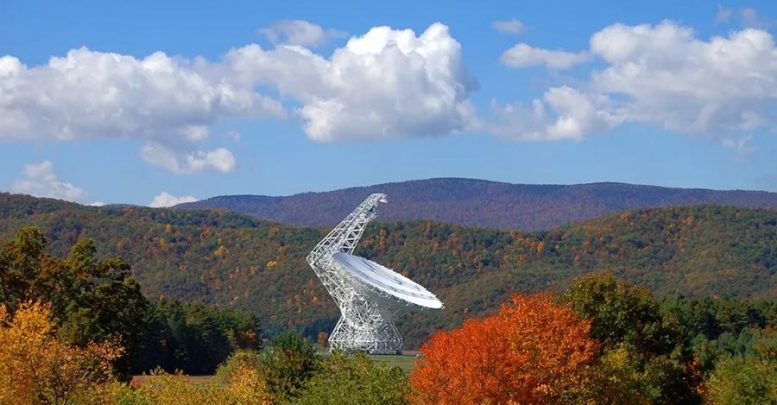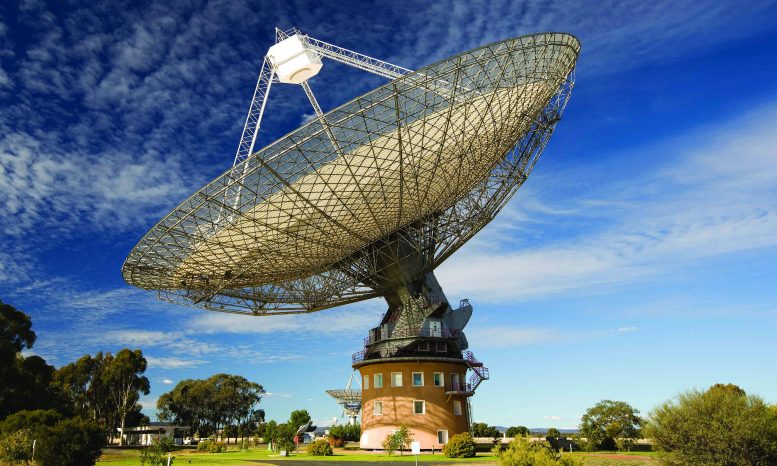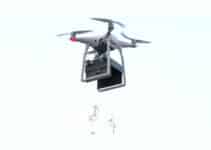
In a significant advancement for the Search for Extraterrestrial Intelligence (SETI), researchers from the University of California, Berkeley have devised a new technique for detecting potential alien radio signals. This technique involves analyzing signals for signs of having traversed interstellar space, thereby ruling out Earth-based radio interference.
Scientists at the
The Green Bank Telescope, nestled in a radio-quiet valley in West Virginia, is a major listening post for Breakthrough Listen. Credit: GBO / AUI / NSF
New Approach Boosts SETI Search
Breakthrough Listen, the most comprehensive SETI search project, monitors the northern and southern skies for technosignatures using radio telescopes. It also focuses on thousands of individual stars in the plane of the Berkeley SETI Research Center (BSRC), which operates the world’s longest-running SETI program. “It’s the first time where we have a technique that, if we just have one signal, potentially could allow us to intrinsically differentiate it from radio frequency interference. That’s pretty amazing, because if you consider something like the Wow! signal, these are often a one-off.”
The “Wow!” Signal and the Potential of the New Technique
Siemion was referring to a famed 72-second narrowband signal observed in 1977 by a radio telescope in Ohio. The astronomer who discovered the signal, which looked like nothing produced by normal astrophysical processes, wrote “Wow!” in red ink on the data printout. The signal has not been observed since.
“The first ET detection may very well be a one-off, where we only see one signal,” Siemion said. “And if a signal doesn’t repeat, there’s not a lot that we can say about that. And obviously, the most likely explanation for it is radio frequency interference, as is the most likely explanation for the Wow! signal. Having this new technique and the instrumentation capable of recording data at sufficient fidelity such that you could see the effect of the interstellar medium, or ISM, is incredibly powerful.”
The 64-meter Parkes Telescope in New South Wales, Australia, allows Breakthrough Listen to monitor the southern sky. The telescope is operated by the Commonwealth Scientific and Industrial Research Organisation (CSIRO). Credit: CSIRO
Research Behind the New Technique
The technique is described in a paper published on July 17 in The one interesting candidate — dubbed BLC1 — in 2020. Later analysis determined that it was almost certainly due to radio interference, Siemion said.
Siemion and his colleagues realized, however, that real signals from extraterrestrial civilizations should exhibit features caused by passage through the ISM that could help discriminate between Earth- and space-based radio signals. Thanks to past research describing how the cold
Graduate student Bryan Brzycki at the Green Bank Telescope, where he is using a new scintillation-based technique to vet radio signals potentially coming from alien civilizations elsewhere in the Milky Way galaxy. Credit: Bryan Brzycki, Breakthrough Listen
Testing the New Technique
Brzycki is now conducting radio observations at the Green Bank Telescope in West Virginia to show that the technique can quickly weed out Earth-based radio signals and perhaps even detect scintillation in a narrowband signal — a technosignature candidate.
“Maybe we can identify this effect within individual observations and see that attenuation and brightening and actually say that the signal is undergoing that effect,” he said. “It’s another tool that we have available now.”
The technique will be useful only for signals that originate more than about 10,000 light years from Earth, since a signal must travel through enough of the ISM to exhibit detectable scintillation. Anything originating nearby — the BLC-1 signal, for example, seemed to be coming from our nearest star, Proxima Centauri — would not exhibit this effect.
Reference: “On Detecting Interstellar Scintillation in Narrowband Radio SETI” by Bryan Brzycki, Andrew P. V. Siemion, Imke de Pater, James M. Cordes, Vishal Gajjar, Brian Lacki and Sofia Sheikh, 17 July 2023, The Astrophysical Journal.
DOI: 10.3847/1538-4357/acdee0
Other co-authors of the paper are James Cordes of Cornell, Brian Lacki of BSRC and Vishal Gajjar and Sofia Sheikh of both BSRC and the SETI Institute. Breakthrough Listen is managed by the Breakthrough Initiatives, a program sponsored by the Breakthrough Prize Foundation.





